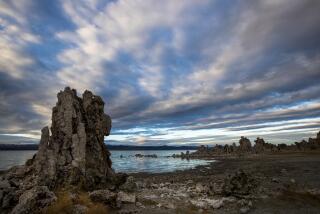California’s ‘Dead Sea’ Teems With Life
- Share via
It’s one of the grand landscapes of the American West--an ancient lake cradled by volcanoes, glacier-carved canyons and snowy peaks. Visitors marvel at the eight-mile-long (north to south) and 13-mile-wide lake and its unusual tufa towers, remarkable limestone creations that rise from the lake in magnificent knobs and spires.
Not everyone finds the Mono Basin magnificent. Too desolate and too weird, some folks think. In his 1872 travel narrative “Roughing It,” Mark Twain described Mono Lake as “a lonely tenant of the loneliest spot on earth” and its setting as “a lifeless, treeless, hideous desert.”
Ever since Twain’s time, Mono Lake has been called “California’s Dead Sea,” but it’s actually a life-support system for great numbers of birds. California gulls fly in from the coast to nest on the lake’s isles. About 90% of the state’s population of this species of gull is born on Mono Lake.
About 800,000 eared grebes, duck-like diving birds, have been tallied at the lake. Mono’s summertime winged visitors include Wilson’s and red-necked phalaropes, species that commute from wintering grounds in South America.
Primary bird food is the brine shrimp, which, like other organisms dependent on Mono’s waters, has evolved over the last million years or so to adapt to an extremely saline habitat.
While Mono is anything but a dead sea, it was, until recently, a dying lake. Beginning in 1941 and continuing for more than half a century, the Los Angeles Department of Water and Power diverted most of the major creeks and rivers that had sustained Mono Lake for centuries. Such diversions caused the lake level to drop 40 feet and its waters to double in salinity.
The resultant damage to the lake’s ecological integrity and to Mono Basin’s wildlife habitat prompted the Mono Lake Committee and the National Audubon Society to take legal action to stop this drastic drain. After 16 years of conservation efforts and legal challenges by citizen activists in numerous courts and forums, the State Water Resources Control Board agreed to raise the lake level in 1994.
Theoretically and legally, at least, Mono Lake has been “saved.” However, much shoreline and wildlife habitat restoration will be necessary to return the lake to ideal environmental health.
You can learn more about the lake and conservation efforts at the Mono Basin National Forest Scenic Area Visitor Center, located on the outskirts of Lee Vining. The Mono Lake Committee maintains an information center and attractive little gift/bookstore in Lee Vining.
Travelers with limited time can get a quick look at the lake and some tufa formations with the help of two boardwalk trails located at Old Marina on the west shore and Mono Lake County Park on the northwest shore. The best place to observe Mono’s most compelling natural attraction--its tufa towers--is the South Tufa Area, explored by a short interpretive trail. The trail’s shoreline segments will no doubt need to be relocated periodically as the lake rises and reclaims its ancient bed. Tufa towers are formed when calcium-rich freshwater springs bubble up into the carbonate-saturated alkaline lake water. This calcium-carbonate commingling results in limestone formations--the tufa spires.
Trail-side interpretive signs explain more than most hikers will want to know about the lake’s food chain of algae, billions of brine flies and countless shrimp, as well as gulls, grebes and other migratory birds. Some visitors, overwhelmed by the lake’s majesty, might be disappointed to learn that Mono is the native Yokut word for “brine fly.”
South Tufa Trail leads past some landlocked tufa formations, then skirts the lake shore for a look out at those protruding from the midst of Mono. Loop back to the parking area if you wish, or extend your hike by continuing on to Navy Beach, the best swimming area.
Access: From Interstate 395, about five miles south of the hamlet of Lee Vining, turn east on California 120 and drive five miles to the signed turnoff for the South Tufa Area/Mono Lake Tufa State Reserve. Turn left and proceed a mile on a good gravel road to a parking area near the trail head. There’s an entry fee of $2 per person.
(BEGIN TEXT OF INFOBOX / INFOGRAPHIC)
Hiking/ Mono Lake
South Tufa Trail
WHERE: Mono Lake Tufa State Reserve, Mono Basin National Forest Scenic Area.
DISTANCE: 1 to 2 miles round trip.
TERRAIN: Arid plain, ancient lake with Sierra Nevada backdrop.
HIGHLIGHTS: Tufa towers, craters, flocks of birds.
DEGREE OF DIFFICULTY: Easy.
FOR MORE INFORMATION: Mono Basin National Forest Scenic Area P.O. Box = 429, Lee Vining, CA 93451, tel. (760) 647-3044. Mono Lake Tufa State = Reserve, tel. (760) 647-6331.
More to Read
Sign up for The Wild
We’ll help you find the best places to hike, bike and run, as well as the perfect silent spots for meditation and yoga.
You may occasionally receive promotional content from the Los Angeles Times.






